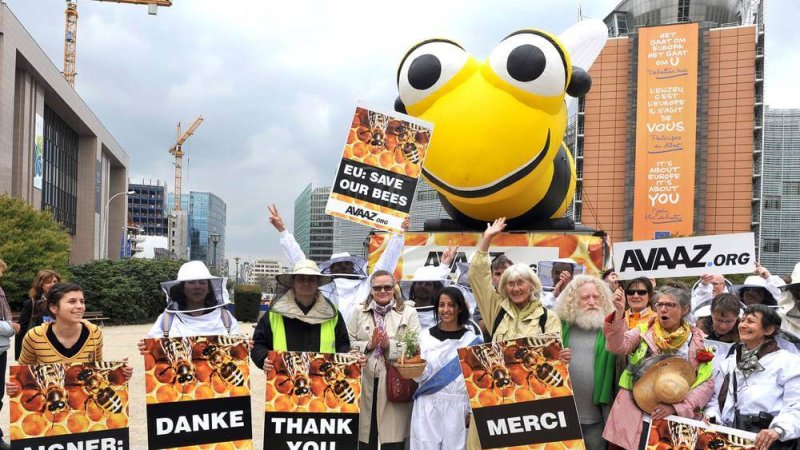Yes, The Risk-Monger is angry. Farmers’ crops are failing at an alarming rate and someone should inform these proud precautionistas in Brussels that it’s their bloody fault.
A litany of failure
Before these civil servants in DG Santé raise a glass to celebrate their achievements over the last Commission in defending what was never under threat; before they empty their desks and move on to lucrative new careers; before they try to write a positive spin on the last five years of regulatory negligence, it seems reality is coming to bite them in the face. This Commission will leave office aware they have decimated European farming far greater than any wide-scale drought or war could ever have done. The impact on EU agriculture from the precautionary zealots in DG Santé should be compared to swarms of locusts being left to consume the land.
A reminder of the European Commission’s litany of failure towards EU farmers:
- Inaction to apply EU procedures when the Food and Feed Committee was unable to reach a decision to renew glyphosate for 15 years;
- Failure to defend the EU risk assessment process now being re-written by NGOs and activist groups hell-bent on destroying EU innovation:
- Enforcing an illegitimate Bee Guidance Document allowing DG Santé to rush through a precautionary ban on three neonicotinoid insecticides;
- Submitting to activist pressure from the Greens and the organic food industry lobby to extend the neonic ban to all applications (and not just flowering plants) without any evidence or justification;
- Ten years of inaction on defining novel breeding techniques, leaving the decision to consider them as GMOs up to the European courts addressing a complaint from French NGOs and peasant associations;
- Allowing NGOs to push through a hazard-based, precautionary approach to regulating endocrine disrupting chemicals meaning that a majority of crop protection substances coming up for renewal will not be able to prove, with certainty, that they do not have endocrine disrupting properties.
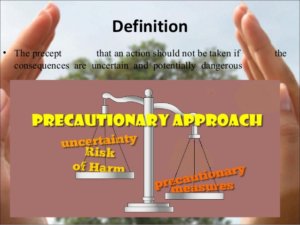
The key attraction of the precautionary playbook is that it is perceived as a “victim-free” solution to difficult decisions. Regulators can pretend to be protective and they would be long gone from their positions by the time any consequences from their irresponsible inaction comes to light. However, in the case of the precautionary ban on neonics, EU farmers, consumers, the environment and bees are suffering far sooner than these regulators had expected.
The dose precision in today’s crop protection applications is impressive. Scientists have managed to calibrate pesticide doses to such a low level as to attain the dose required while ensuring to not over use or waste pesticides – in other words, farmers are using just enough dose to kill the targeted pests while protecting the environment and reducing residue levels. This balance between efficacy of substance and safety to the environment is fragile – any shift in the balance will lead to consequences. Thus anyone who understood farming would get how removing the most efficient technology and leaving farmers with older, less effective tools could be disastrous to EU agriculture. The poorly advised precautionistas in DG Santé don’t understand farming.
Two years ago, The Risk-Monger warned that EU oilseed rape farmers would lose the means to control the cabbage stem flea beetle within five years of the neonic ban. He was wrong. Only two years following the EU neonicotinoid ban and that shit has already hit the precautionary fan. In the UK, one of the few Member States where there was no derogation on neonics, the cabbage stem flea beetle has been decimating crops this year and farmers are fast giving up hope.
Why did farmers use neonics?
The cabbage stem flea beetle attacks plants like oilseed rape (OSR) from the inside of the plant stock. Within literally two days of discovering an infestation, a farmer would need to spray the crop with a variety of insecticides in order to have a chance of saving the crop. This implies regular walking of the fields, frequent insecticide applications and increased costs for farmers. If the flea beetle strikes when the plants are just emerging, the OSR crop has little chance of survival and, if the farmer is lucky, he or she may have time to redrill or leave the field for other applications. Given the lower efficacy of the older, foliar insecticides, OSR was becoming too great of a risk to farm in many northern climates.
It was quite logical then for farmers to plant OSR seeds treated with neonicotinoids. The systemic plant protection meant the plant was protected in the stalk at just the right level to resist the flea beetle (but not risking larger beneficial insects). Yields went up, as did acreage. Now that neonics have been removed from the farmers’ plant protection toolbox, it did not take too long for the cabbage stem flea beetle to make its ugly return. But pest infestations don’t happen overnight (it can take years to slowly build up to dangerous levels) which is why many Santé officials naively felt, in the year following the neonic ban, that things were just fine (and started to move to ban all neonic applications).
The farmers are suffering
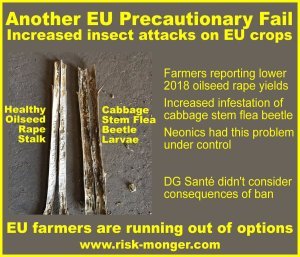
Two years ago I had the privilege of going on a one-week speaking tour to farming communities across Southern (picture to the right) England. I got to know many farmers very well (apologies, I had promised a similar tour across the Midlands – once I get well I plan to honor that commitment) and since then they have regularly kept me abreast on the state of their crops. The 2018 OSR crop yield was down and showing signs of a resurgent flea beetle. I noticed last autumn a good number of farmers had lost their first OSR crop to the cabbage stem flea beetle within weeks and tried to drill a second crop.
But after the 2018-19 winter, the true level of the Santé neonic precaution disaster started to become evident. The cabbage stem flea beetle has decimated this year’s OSR crop in certain regions of the UK, leaving farmers to pull oilseed rape from their future crop rotations. UK farmer Charlie Rowland had to watch as 125 acres of OSR were lost to the flea beetle. The conversations on Charlie’s post were quite interesting – he had tried everything but concluded OSR no longer has a future on his farm.

Rich from Headys Farm also concluded he could no longer grow OSR (not only did he lack the tools to fight the flea beetle, the tools he used to control slugs were also being taken away from his toolbox by zealous regulators). Trying different solutions, including co-cropping, he had lost six of seven fields this year and this last one, in the video, was struggling to survive.
Can we still grow oilseed rape? We use it as a break crop as it’s from a different family to wheat & barley and can therefore break the disease, weed and pest cycles reducing our reliance on sprays. But growing it is evermore challenging! #pegeons #slugs #fleabeetle pic.twitter.com/lxkDr4ZgAP
— Headys farm (@HeadysFarm) February 21, 2019
Even harder to accept, Headys Farm used OSR in a rotation to help prepare the soil for the following crops (reducing weed and pest varieties). As he is giving up on OSR, more crop protection tools will likely have to be used on other crops. If policymakers in DG Santé would like to learn a bit about farming (a stretch, I get it, but just in case), I recommend they follow the educational videos from Headys Farm on twitter.
It is absolutely heartbreaking for a farmer to lose a crop. But it is not just the farmer who suffers. Consumers pay more for imports (often from areas with less sophisticated crop protection measures), the environment suffers and worst of all, the bees suffer.
How the environment and bees suffer from precautionista good intentions
Whenever well-meaning activists and virtue-signalling policymakers get together to solve problems and save the world, that is usual the moment when the Risk-Monger mutters an “Oh Dear!”
Firstly, precaution is most often a backward driven concept. It is applied, and even called a “principle,” when people are struggling to remove a conflicting obstacle or uncertainty. Rather than finding a better way, precaution is applied to get back to an older way (forgetting why there was good reason to no longer follow that way). Going back to a period before neonic seed dressings meant farmers would lose the battle against the resilient cabbage stem flea beetle and abandon planting OSR crops altogether. This means removing OSR from a farmer’s crop rotation plan leaving the soil management strategy worse off (and farmers will likely soon have to pull sugar beets from their crop rotations due to the same precautionary madness).
Add to that the vain attempts to save some of the oilseed rape crops with increased foliar spraying with older technologies and the effect on soil and water and the madness of the precaution principle starts to become painful to watch. Seed dressings were designed to lessen environmental impact. Did Santé think about agricultural soil health when they banned neonics? Nope! Not in their remit.
As Rich Heady’s video showed, farmers are also gathering more knowledge on how to use crop rotations to control varieties of weeds and keep insect populations down. I also raised this in my article on cover cropping. Without OSR in the rotation, farmers will have to come up with other solutions.
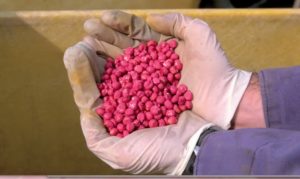
The most ridiculous consequence of DG Santé’s misguided neonic precaution folly is that they have made matters worse for the pollinators – the whole reason for their virtue signalling strategy in the first place. As more farmers pull OSR from their fields, there will be far fewer rich sources of pollen for bees (the beekeepers have raised this nutrition concern). Even more ridiculous, as those struggling to save their OSR crops spray the harsher, older pyrethrins bees will suffer far more. Why couldn’t the activists and their servants in DG Santé have seen that tragedy coming. As I have often said, this precautionary fail was never about saving the bees.
So it is clear DG Santé’s precautionary ban on neonicotinoids has been a catastrophic failure for farmers, consumers, the environment and the bees. But as these soulless regulators have moved on to “solve” other problems, we should ask: What is the source of the neonic failure? Did the ignorance come from the top down or the bottom up?
A failure from the top down
The Juncker Commission has been built on propagating ignorance for internal control. Previous European Commission presidencies relied on interservice consultations – where a policy issue was managed by multiple DGs in dialogue ensuring that all interests were well represented. REACH, a regulation I was heavily involved in, for example, involved DG Environment, DG Enterprise and DG Sanco allowing different stakeholders and governments to engage at appropriate levels. It was messy but all sides were heard. In the present regime the only dialogue seemed to be between the directorate-general managing the policy issue and Martin Selmayr, the Bismark of Brussels. With a weak leadership above him, this shadowy civil servant was able to keep the Commissioners better under check in isolation.
But an unfortunate result of this bastardization of the EU policy process going back to the White Paper on Governance is that a single DG does not represent the complexity found in most issues. DG Santé is responsible for protecting human and animal health in the EU. It is not concerned with whether farmers will have the tools to farm, whether food manufacturers will have access to resources or whether researchers will have markets for their innovations.
Without DG Agriculture or DG Research coming into the dialogue process via interservice consultations, ignorance is willfully promoted. The Health Commissioner is not obliged to listen to farmers or inform himself about how his policies will affect other stakeholders. Selmayr’s legacy of centralizing power has led to a more ignorant, unaccountable Commission acting against the interests of its citizens. Now Selmayr is heading SecGen so Timmerman’s much vaunted better regulation strategy looks more like a farce than a failure.
A failure from the ground up
The EU precautionary ban on three neonicotinoid seed treatment technologies showed how the lack of interservice consultation also invited ignorance at the desk officer level. These EU officials, alarmed by activist campaigns of bee declines and a colony collapse in another part of the world, felt they needed to be seen to be acting. Pushed on by a dragnet structure in EFSA set up by an anti-pesticide industry director inside the then DG Sanco and a zealous French minister of the environment, the Commission enforced a ban on these neonicotinoids, claiming the need to save the bees.
They ignored evidence from their own scientists showing there was no decline in pollinator populations, did not publish the findings of their own commissioned impact assessments on farmers from the initial ban and then pigheadedly went forward and extended the neonic ban to all outdoor applications (even on non-flowering plants like sugar beets that have no effect on pollinators). Farmers have no voice in DG Santé decisions and DG Santé has no understanding or interest in EU farming challenges.
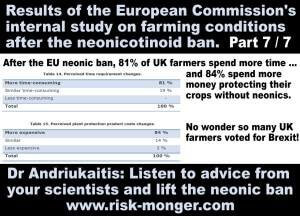
One good example of how little civil servants in DG Santé understood farming, they did not realize what would happen to farming if they took an important crop protection technology out of the farmers’ toolbox. Did they want to believe, as activist groups like Pesticide Action Network or Friends of the Earth claim, that we can farm without insecticides? Maybe they bought into the prejudice of activist scientists like the indefatigable Dave Goulson who think farmers don’t even know that neonics don’t work. One thing is for certain, DG Santé did not read the JRC study they had commissioned showing how farmers, the environment and bees were suffering from their neonic ban. Farmers were not their concern.
How much more will EU farmers have to suffer from this precautionary madness? Sadly I fear I cannot offer them much hope. The upcoming European elections look ready to produce a fine yield for Green Party candidates who seem hell-bent on imposing their anti-technology, medieval ideology on rural communities. This will likely spell the end of more crops in rotation (soil will suffer), fewer crop protection tools available for farmers (the economy will suffer) and the end to the innovative solutions from conservation agriculture pioneers (the environment will suffer).
It would take a courageous leader to stand up to the mass hysteria rattling around the streets of Brussels from the EU-funded activist groups. The present leaderless Commission has produced only cowardice and no accountability to the harm caused by their willful ignorance.
A special thank you to all of the farmers who have shared their experiences and views with me. You don’t deserve one bit of this bullshit Brussels has dumped on your profession.
David Zaruk has been an EU risk and science communications specialist since 2000, active in EU policy events from REACH and SCALE to the Pesticides Directive, from Science in Society questions to the use of the Precautionary Principle. Follow him on Twitter @zaruk
This piece originally ran at the Risk Monger as The Neonics Precaution Fail: How Farmers are Suffering from EU Regulatory Negligence and has been republished here with permission.

